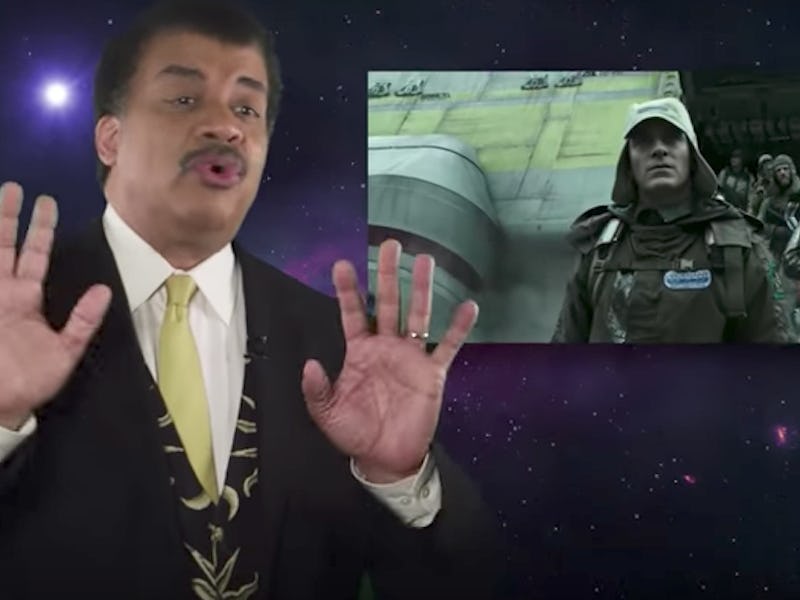Neil deGrasse Tyson Gets Genetics Wrong in 'Alien: Covenant' Review

Astrophysicist, science communicator, and resident hater Neil deGrasse Tyson recently partnered with The Late Show with Stephen Colbert to offer his scientific hot takes on new science fiction movies. While he criticizes Guardians of the Galaxy Vol. 2 for botching the physics of sound in space and rolls his eyes at Alien: Covenant’s premise that humans would explore new planets before robots, there was one bit of science he could get down with: In the new Alien movie, the crew is made up of couples who are about to kickstart Homo sapiens’ first attempt at large-scale colonization outside their home planet — an idea that Tyson was willing to entertain from a scientific point of view.
Unfortunately, his hot take wasn’t quite correct.
“They’re sending in people who are just to make babies and start a new civilization — that’s cool,” Tyson says. “Turns out, genetic research shows that only about 12 families started all human life in North and South America, across the Bering Strait. So it’s not a weird thing to imagine just a few fertile couples beginning an entire new generation of human species.”
Inverse fact-checked Tyson’s statement with anthropologist Connie Mulligan, Ph.D., whose lab at the University of Florida analyzes the links between human genes and their evolutionary history. Mulligan says that thinking about the peopling of the New World in terms of numbers of families isn’t common practice, but she theorizes that Tyson’s statement could be based on the idea that there are certain “mitochondrial haplogroups” that are the founding haplogroups of the Americas. A haplogroup is a genetic population whose members share a common ancestor. Each haplogroup can be thought of as a closely related group on a genetic family tree.
“On one hand, a haplogroup is a group of genetically related individuals, so his statement could make sense in that light,” Mulligan said in an e-mail. “On the other hand, a haplogroup would not look like a family in any sense that we have.”
While a husband and wife can clearly make up a family unit, they could come from different mitochondrial haplogroups, Mulligan says. If it’s true that haplogroups drove Tyson’s line of thinking — with just the video, we can only speculate — then he should have said that it was “approximately ten groups of people who were genetically closely related that settled the New World.”
Dennis O’Rourke, a professor of anthropology at the University of Kansas, also told Inverse that he has never heard of the ‘12 families’ scenario. O’Rourke specializes in analyzing ancient DNA to investigate and understand the initial colonization of the Western Hemisphere.
Mitochondrial DNA (mtDNA) is maternally inherited and doesn’t recombine with other types of DNA, which allows it to serve as a record of human migration. Because it doesn’t go through recombination with other DNA sources, mtDNA accumulates over time. When there’s evidence of identical mutations in mtDNA, it indicates that human groups who share them have a common lineage, whether or not they are geographically separated.
That’s important, especially when it comes to early human migration. We can’t definitively say exactly when — and which groups — migrated to North and South America. Geneticists have pinpointed high frequencies of five specific mtDNA haplogroups among Native Americans in North America, suggesting that they likely share DNA with ancient populations of Northeast Asia. In February, scientists discovered that fossils found in Brazil’s earliest settlements share a common ancestor with modern-day Asians. These findings support the idea that there were multiple migration waves from northeast Asia to the New World, which scientists describe as “a period of extensive gene flow between Asian and American populations.”
The exact timing of this period is still up for debate. Until recently, it was widely believed that humans came over a land bridge through the Bering Strait throughout the late Pleistocene and early Holocene era — but in April, researchers announced a discovery suggesting humans came to California 100,000 years earlier than previously believed. So far, researchers only have mastodon bones with evidence of human butchering as evidence for this finding — but we can bet that if human fossils are eventually found, scientists will race to test their genetic components. That will be great for science — but not so great for Tyson’s twelve-family theory and science cred.